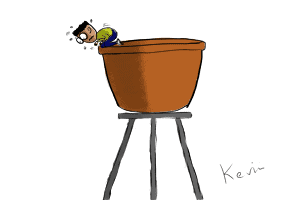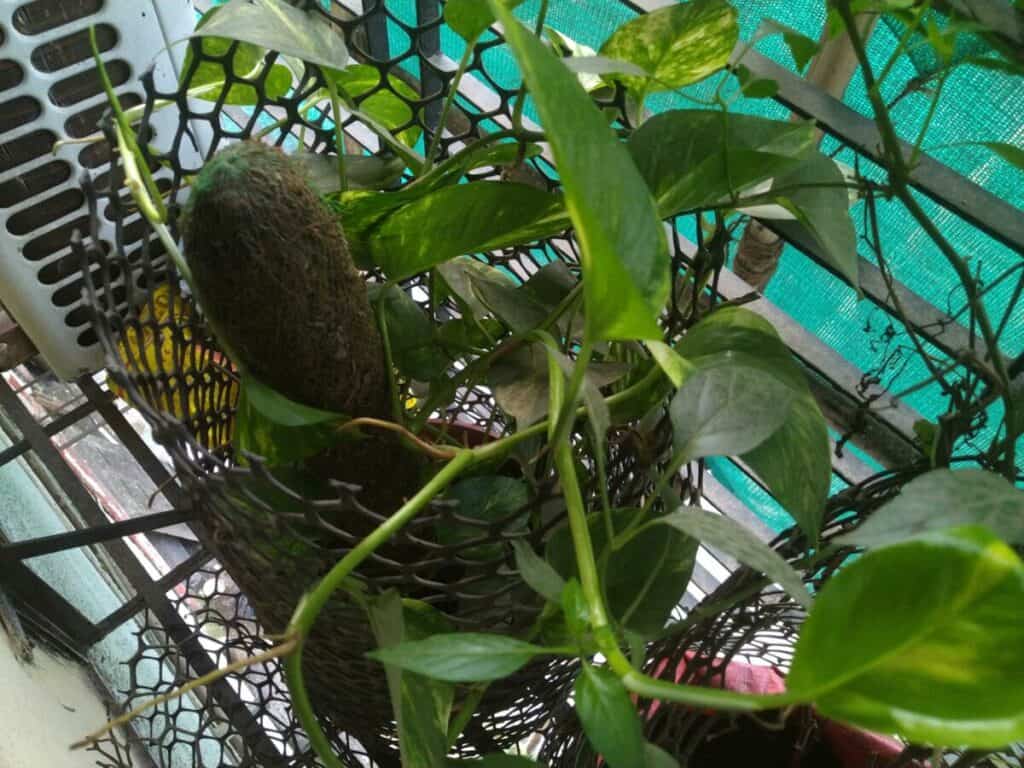You’ve seen it at your neighbor’s garden.
The plant pots are placed at a height. And you wonder why is that done?
Are there some benefits and should you do the same for your potted plants?
Container potted plants should be elevated because it improves drainage, air circulation, and pest protection. You can use pot stands, pot feet, pot risers, or materials such as bricks, stones, books, or trays to elevate potted plants.
In this post, let’s look at what benefits you get with elevated potted plants, how you can elevate your own plant pots, and the precautions you should know.
Let’s begin.
What are the benefits of elevating potted plants?
1. Improved drainage
The pots have drainage holes at the bottom that help remove excess water from the soil after watering. Elevating the pots helps prevent the drainage holes from getting blocked.

So, you won’t have the problem where the potting soil remains moist for a long time due to sitting in water. It helps prevent overwatering problems in the potted plant that can cause root rot.
2. Better air circulation
Since you elevate the pot, there will be good air circulation through the drainage holes. The plants will have better spacing which also encourages good air circulation.
Good air circulation reduces chances of a humid condition near the potted plants. And prevents many types of fungal diseases from affecting the plant.
My container plants are on my balcony grill which acts as an elevation and allows good drainage and plenty of aeration. For some plant pots that are placed on the ground, I used cinder blocks lying around to give them elevation.

3. Helps prevent some pests
There are some plant pests that reach the plant from the ground, such as slugs and snails. When you elevate the pots, these pests cannot attack the plant. But this works best if you use hanging planters that don’t have any contact with the ground.
4. Helps reduce strain
It can be tough tending to potted plants when you have to bend your back. When you elevate the pots, it becomes easier to maintain the plants for watering, pruning, and fertilizing.
This will reduce the strain on your back and make gardening comfortable. This is an important benefit for seniors looking to grow their own garden.
5. Adds an aesthetic appeal
You can improve the look of your container garden by elevating the pots using stands, hanging planters, and platforms.
Using different sizes and shapes of potted plants makes it more visually interesting than placing all pots on the ground.
How high off the ground should potted plants be?
The potted plants should be at a height of 2-4 inches, so it’s enough to get all the benefits that we saw. It also is practical using pot stands or feet that you get at the store.
You can elevate pots higher if you want and you can get stands that are taller. Just make sure that the material you used to elevate the pots is sturdy enough if the plants and pots are large.
How to elevate the plant pots above ground
The first step would be to choose the pot feet, pot risers or stands you’ll use to elevate the pots. You’ll find these in a garden center or online store. Make sure to get ones that are of good quality and durable. If you have a low budget, you can even use a simple stack of bricks or stones to elevate the pots.
Take one of the pot feet or riser and place it at the location you want for the plant pot. Now lift the plant pot and place it on this pot feet.
You can then push the required pot feet at different areas under the plant pot to give it good support. And remove the pot feet that you had placed earlier for support.
Place the pot feet or stands evenly under each corner of the pot to prevent it from wobbling or tipping over. The pot should be stable and level.
How to choose the right type of pot feet or stands
The most important factor would be the quality of the material. You need something that will support the weight of the plant pot, especially if the plant and pot are heavy.
You can get the pot feet or stands made from wood, metal, or plastic based on your choice. I would suggest choosing plastic because it will be durable and last longer.
Choose pot feet or stands that have at least 2-4 inches height, so there is good airflow and drainage possible.
Below are some pot feet and stands that I recommend.
What are some alternatives you can use as pot stands?
Bricks or cinder blocks: These can be stacked to create a sturdy and inexpensive pot stand.
Wooden pallets: These can be used as a base for pot stands, or the slats can be used individually as pot feet.
Terra cotta saucers: These can be turned upside down and used as pot feet or stands.
Old furniture: Chairs, stools, and tables that are no longer in use can be repurposed as pot stands.
Books or magazines: Stack these to create a temporary pot stand. Be sure to use sturdy books and stack them evenly to prevent the pots from tipping over.
Old baking pans or trays: These can be used as pot stands, and the raised edges help contain any water runoff.
PVC pipes or tubing: Cut into short lengths, these can be used as pot feet or to create a simple pot stand.
Should you put anything in the pot’s bottom for elevation?
I had a thought that could we place material inside the pot to achieve elevation. This could be filler material such as packing peanuts, broken terracotta pieces, or newspaper.
So, this would achieve the same benefits of raising the soil above the bottom of the pot and ensuring good drainage.
But I realized it would not give all the benefits of using things like pot stands. There would still be chances that the drainage holes were touching the ground and blocked.
I would suggest using a combination of both. Use pot stands to elevate the pots and use filler material to get other benefits, such as a lower volume of potting soil.
What are precautions to take for elevated plant pots?
You want to ensure the plant pots are on stable pot feet or stands. Make sure you center the pot on the supports and won’t topple over. This can be very important if your garden gets strong winds. Your kids or pets also have chances of causing the pots to fall down.
I would suggest you don’t keep the elevated plant pots in an area that would block any walkways or pathways. It could be a tripping hazard and cause the pots to fall.
When you get the pot stand or feet, check how much weight they can withstand. You need something that is durable and can hold the plant pots you have.
Plant stands or feet made from plastic, metal, or wood will be durable. But it’ good to monitor them as part of regular maintenance. If you find the material has degraded, it would be time for replacement or you risk the pot falling over.
Further reading
Now we know it’s important to elevate potted plants and encourage better drainage and air flow. This is one of the basics of container gardening. I’ve written a lot more about this in the post below.

Fact Checked, Written, and Published by Kevin Rodrigues
Kevin is the founder of Gardening Mentor, a website that aims to teach people to grow their own food in a limited space. As a self-taught gardener, Kevin has spent several years growing plants and creating gardening content on the website. He is certified in Home Horticulture and Organic Gardening from Oregon State University. He has a Post Graduate Diploma in Horticulture and Landscape Gardening from Mumbai University.
Read more
